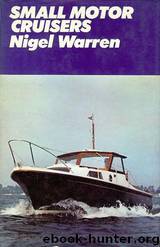Small Motor Cruisers by Nigel Warren

Author:Nigel Warren
Language: eng
Format: epub
Publisher: For the Benefit of Mr. Kite
Published: 1974-12-31T16:00:00+00:00
True marine engines
The distinguishing mark which separates true marine engines from the automotive variety is the r.p.m. at which they run. Installed in a boat a slow-speed true marine engine appears to give effortless speed on opening the throttle a little. The response is immediate and the boat seems to cover a lot of ground per revolution of the engine. But there seems to be little power left when opening the throttle wide. The range of revs is much less; typically, they idle at 600rpm with a maximum of 1800rpm. This means that, even idling, the boat will travel at a fair speed. On the other hand a high speed automotive engine in a boat gives the impression of running fast for little result in terms of boat speed. It is not until 2000-3000rpm is reached before the boat seems to go. Naturally more noise comes from a high speed engine but, on the other hand, less vibration. A high speed diesel can be so noisy that one feels physically sick. The noise level is made worse if the engine is situated in a wheelhouse where the noise bounces back off the roof. Two true marine engines will now be examined, the Stuart Turner 10hp two-stroke petrol engine and the Sabb 10hp diesel. The Stuart Turner is a 2-cylinder two-stroke running on a petrol/oil mixture, weighs 258lb and costs almost £300. The Sabb is a single cylinder engine weighing 440lb and costs about £525. Again the disparity between petrol and diesel is clear. What is noticeable is that these engines weigh almost as much as the Ford engines of much greater horsepower. The Stuart Turner engine has a maximum r.p.m. of 1650 and the Sabb of 1800. Whereas direct drive is adequate for these engines, automotive engines usually require a reduction ratio of at least 2:1. Both the Sabb and the Stuart Turner are bolted rigidly down to the hull. It is difficult to mount flexibly single or twin-cylinder slow-running engines so as to reduce vibration transmitted to the boat. The Sabb diesel has the reputation of giving a not-unpleasant ‘thump-thump’ noise. Petrol engines of the true marine variety often have magneto ignition rather than a coil. There is still a contact breaker inside the magneto (which needs to be replaced regularly), but the magneto is usually a drip-proof item. On the other hand magnetos tend to age and begin to fail intermittently when hot in a most irritating manner. My own opinion is that magnetos are best avoided or converted by adding a car-type coil, still utilising the distributor part of the magneto. Thus the high tension current is produced by the battery and coil rather than the suspect magneto windings. The advantage of a magneto is that it makes the engine independent of a battery. Again these remarks about Sabb and Stuart Turner engines could equally well be applied to such makes as Brit, Wickstrom, Kelvin and Gardner.
A similar type of engine results from the marinisation of industrial engines – such as Lister.
Download
This site does not store any files on its server. We only index and link to content provided by other sites. Please contact the content providers to delete copyright contents if any and email us, we'll remove relevant links or contents immediately.
Whiskies Galore by Ian Buxton(41720)
Introduction to Aircraft Design (Cambridge Aerospace Series) by John P. Fielding(33017)
Small Unmanned Fixed-wing Aircraft Design by Andrew J. Keane Andras Sobester James P. Scanlan & András Sóbester & James P. Scanlan(32685)
Aircraft Design of WWII: A Sketchbook by Lockheed Aircraft Corporation(32164)
Craft Beer for the Homebrewer by Michael Agnew(18082)
Turbulence by E. J. Noyes(7895)
The Complete Stick Figure Physics Tutorials by Allen Sarah(7265)
The Institute by Stephen King(6860)
Kaplan MCAT General Chemistry Review by Kaplan(6823)
The Thirst by Nesbo Jo(6759)
Bad Blood by John Carreyrou(6477)
Modelling of Convective Heat and Mass Transfer in Rotating Flows by Igor V. Shevchuk(6354)
Learning SQL by Alan Beaulieu(6159)
Weapons of Math Destruction by Cathy O'Neil(6085)
Man-made Catastrophes and Risk Information Concealment by Dmitry Chernov & Didier Sornette(5878)
Permanent Record by Edward Snowden(5682)
Digital Minimalism by Cal Newport;(5588)
Life 3.0: Being Human in the Age of Artificial Intelligence by Tegmark Max(5405)
iGen by Jean M. Twenge(5326)
